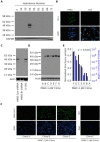Aberrant expression of the embryonic transcription factor brachyury in human tumors detected with a novel rabbit monoclonal antibody
- PMID: 25605015
- PMCID: PMC4467120
- DOI: 10.18632/oncotarget.3086
Aberrant expression of the embryonic transcription factor brachyury in human tumors detected with a novel rabbit monoclonal antibody
Abstract
The embryonic transcription factor brachyury is overexpressed in a variety of human tumors, including lung, breast, colon and prostate carcinomas, chordomas and hemangioblastomas. In human carcinoma cells, overexpression of brachyury associates with the occurrence of the phenomenon of epithelial-mesenchymal transition (EMT), acquisition of metastatic propensity and resistance to a variety of anti-cancer therapeutics. Brachyury is preferentially expressed in human tumors vs. normal adult tissues, and high levels of this molecule associate with poor prognosis in patients with lung, colon and prostate carcinomas, and in breast cancer patients treated with adjuvant tamoxifen. Brachyury is immunogenic in humans and vaccines against this novel oncotarget are currently undergoing clinical investigation. While our group and others have employed various anti-brachyury antibodies to interrogate the above findings, we report here on the development and thorough characterization of a novel rabbit monoclonal antibody (MAb 54-1) that reacts with distinct high affinity and specificity with human brachyury. MAb 54-1 was successfully used in ELISA, western blot, immunofluorescence and immunohistochemistry assays to evaluate expression of brachyury in various human tumor cell lines and tissues. We propose the use of this antibody to assist in research studies of EMT and in prognostic studies for a range of human tumors.
Keywords: EMT; brachyury; monoclonal antibody; prognosis marker; tumor antigen.
Figures




References
-
- Edwards YH, Putt W, Lekoape KM, Stott D, Fox M, Hopkinson DA, Sowden J. The human homolog T of the mouse T(Brachyury) gene; gene structure, cDNA sequence, and assignment to chromosome 6q27. Genome Res. 1996;6(3):226–233. - PubMed
-
- Wilkinson DG, Bhatt S, Herrmann BG. Expression pattern of the mouse T gene and its role in mesoderm formation. Nature. 1990;343(6259):657–659. - PubMed
Publication types
MeSH terms
Substances
Grants and funding
LinkOut - more resources
Full Text Sources
Other Literature Sources
Medical
Molecular Biology Databases
Research Materials

